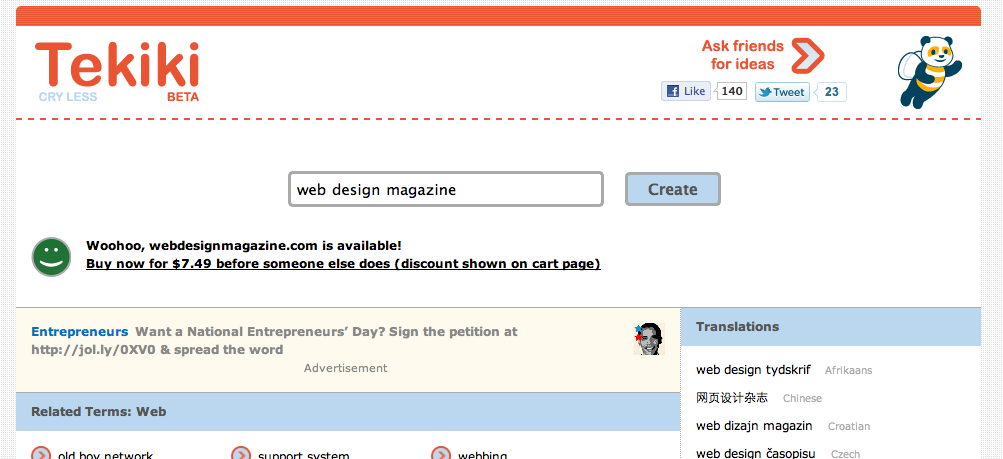Use A Name Creator and 7 Other Tips For Finding The Perfect Domain Name
The domain name is a critical element of your business and brand. It is essentially the online name of your organization, and it is how many people find your web site. Choosing the wrong name is the online equivalent to opening a store in the middle of the desert. Location, location, location is the offline mantra for real estate. Domain name, domain name, domain name could be the online mantra for web sites. Many people consult a name creator like Tekiki or other tools for domain name creation. It is too pivotal a task to not utilize help from others.
Available, but catchy, domain name are in scarce supply. Domain squatters snap up catchy or appealing domains, holding onto them like real estate but with no intent to build on their digital property. Their goal is to wait until an interested party steps forward and matches their asking price. Because squatters can operate domains for cheap — dollars per year — they can afford to amass acres of domains while waiting for attractive bids. Asking prices often run in the thousands of dollars, and reach millions of dollars for coveted domains.
The proliferation of squatters, and legitimate online businesses, means finding a free domain is extremely hard. It requires creativity and persistence, and usually involves a lot of disappointment. It can be deflating to think of the perfect domain name, only to learn it is taken.
As demoralizing as it is to see a great domain name taken, it is equally uplifting to find a free one.
Here are tips for creating and finding a great domain name:
1) Make it easy to spell and pronounce. Difficult or tricky spelling reduces the likelihood of discovery through friends and word-of-mouth. People can’t find your site if they can’t spell it.
2) Explore alternatives. If you love a domain concept, try alternatives. Say you like “cook.com.” Consider other domain options with “cook” as the base and different beginnings and endings, such as “cookly.com” or “mycook.com.” Or see how the word translates into other languages. Perhaps you’ll like how the word looks and sounds in French or Italian.
3) Research on Google. Some words have cultural or secondary meanings. Research on Google and other sites to ensure your domain name does not carry negative or offensive connotations.
4) Check competitors. Look at competitors to ensure your domain name is not too similar. Besides creating user confusion, you might also invite lawsuits around trademark infringement.
5) Protect your domain. If your site has tremendous growth potential, you may also want to buy other domain extensions, or top level domains, such as .NET and .INFO and .ORG. Otherwise, competitors or squatters may buy these related extensions and try to hold you hostage in the future.
6) Use a name creator like Tekiki.com. It helps users create and search domain names. The site shows related terms, translations, and simulates word association by displaying what people say on Facebook and Twitter. Tekiki automatically creates domain alternatives with different suffixes and prefixes, and trendy misspellings (e.g., adding “ly” as a suffix). Besides acting as a domain name creator, Tekiki also checks domain availability and shows research results from Google and Wikipedia.
7) Ask around. Even if you think a domain name is easy to pronounce and spell, or conveys the perfect image of your business, consider consulting friends and strangers for their perspectives. Your domain name may trigger different reactions in different people, and sometimes it’s impossible to predict how people will respond to the name unless you ask around.
8) Concept connection. In the ideal case, the domain name will instantly convey the purpose of your business or organization. Shoebuy.com, for instance, communicates to users what can be found on the web site. This isn’t a strict requirement, however. Many thriving companies, such as Apple and Amazon, attach themselves to domain names that offer no inherent reflection of the business. Straightforward names tend to be more important for organizations without sizable marketing budgets, since they can’t spend money to educate and inform end users. If you don’t plan on investing much in marketing, spend more time thinking of more literal and direct domain names.

